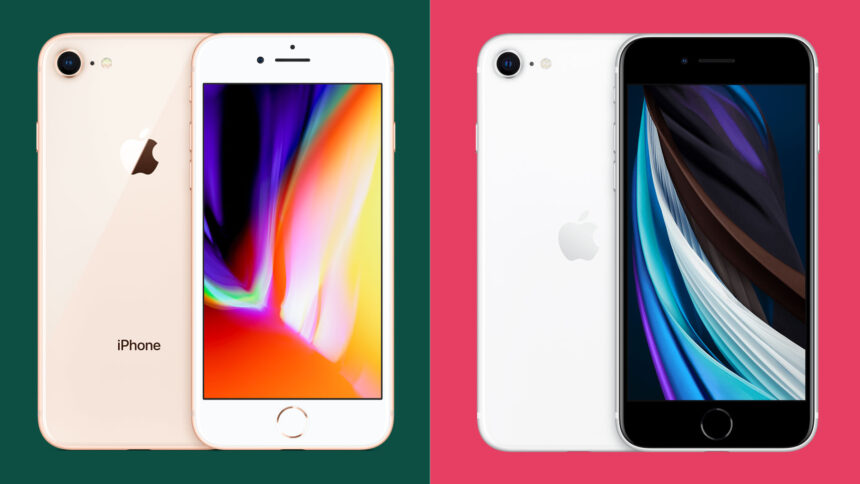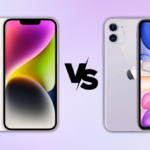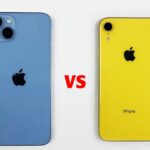When choosing a new smartphone, the decision often boils down to comparing the latest models with the classics. Apple’s iPhone SE and iPhone 8 are two such phones that frequently come up in discussions. Despite their age, both models still appeal significantly due to their design, performance, and value. This article aims to dissect these models, providing a detailed comparison to help you make an informed decision.
Related: iPhone 11 Compared to iPhone xr
iPhone SE vs. iPhone 8
Choosing between the iPhone SE and the iPhone 8 can be tricky. Both offer excellent value at different prices but cater to different needs. This comparison aims to help you decide which model best fits you.
Design and Display:
| Feature | iPhone SE | iPhone 8 |
|---|---|---|
| Design | Classic iPhone design with Touch ID home button | Modern design with larger bezels and no home button |
| Display | 4.7-inch Retina HD LCD | 4.7-inch Retina HD LCD |
| Resolution | 1334 x 750 pixels | 1334 x 750 pixels |
The iPhone SE and iPhone 8 share a striking design resemblance, featuring the classic iPhone look with aluminum frames and glass backs. However, the devil is in the details. The iPhone SE, being the newer of the two, incorporates slightly improved materials and build quality, offering a more resilient design against the tests of time.
Both models boast a 4.7-inch Retina HD display, yet the iPhone SE comes with True Tone technology, which adjusts the screen’s white balance to match the ambient light in your environment. This feature makes for a more comfortable viewing experience under various lighting conditions. Despite their similar appearances, the SE’s display enhancements provide a subtle yet appreciated upgrade over the iPhone 8.
Camera:
| Feature | iPhone SE | iPhone 8 |
|---|---|---|
| Rear Camera | 12MP wide | 12MP wide |
| Front Camera | 7MP | 7MP |
| Video Recording | 4K at 60 fps | 4K at 60 fps |
On paper, the main cameras of the iPhone SE and iPhone 8 might seem identical, with both sporting a 12MP rear sensor. However, the iPhone SE leverages a more advanced image processing software, allowing for better low-light performance and more detailed photos. This comparison reveals how software improvements can breathe new life into similar hardware.
The front cameras also tell a similar story, with both phones featuring a 7MP sensor. Yet, the SE supports Portrait Mode and six lighting effects, not available on the iPhone 8. These enhancements make the SE a more versatile option for selfies and video calls, showcasing the power of software in enhancing photo and video quality.
Performance and Battery Life:
| Feature | iPhone SE | iPhone 8 |
|---|---|---|
| Processor | A15 Bionic chip | A11 Bionic chip |
| RAM | 4GB | 2GB |
| Battery Life | Up to 15 hours of video playback | Up to 13 hours of video playback |
Under the hood, the iPhone SE packs the A13 Bionic chip, a significant leap over the iPhone 8’s A11 Bionic. This upgrade translates to faster processing speeds, smoother multitasking, and an overall more responsive experience. The SE’s superior chipset ensures a snappier performance whether gaming or just scrolling through apps.
Battery life is crucial, and both phones deliver all-day battery life under typical usage. However, the iPhone SE benefits from a more efficient chipset, offering slightly better battery endurance than the iPhone 8. Both devices support wireless and fast charging, but the SE’s efficiency means you’ll reach for the charger less often.
Software:
| Feature | iPhone SE | iPhone 8 |
|---|---|---|
| Operating System | iOS 16.7 (as of February 2024) | iOS 16.7 (as of February 2024) |
| Software Support | Supported until at least 2027 | Supported until at least 2025 |
The iPhone SE comes out of the box with iOS 13 and is guaranteed software updates for several years, ensuring access to the latest features and security patches. The iPhone 8, while still supported, started with iOS 11 and will likely reach the end of its update cycle sooner than the SE. This difference is crucial for those who prioritize having the latest software.
Both phones offer a robust iOS experience, but the iPhone SE’s newer hardware allows it to support more recent software features and enhancements. This could include improved AR capabilities, enhanced privacy features, and more that iOS updates bring to the table.
Other Features:
| Feature | iPhone SE | iPhone 8 |
|---|---|---|
| Water & Dust Resistance | IP68 | IP67 |
| Wireless Charging | Yes | Yes |
Both the iPhone SE and iPhone 8 include Touch ID, waterproofing, and stereo speakers. However, the SE introduces the U1 chip for spatial awareness, enhancing AirDrop and future AR applications. This inclusion points towards Apple’s focus on a more interconnected and immersive ecosystem.
Regarding connectivity, both phones support LTE and Wi-Fi 6, but the SE benefits from a wider range of LTE bands and a faster Wi-Fi connection. These improvements ensure that the SE will provide a more reliable connection in more places than the iPhone 8
Pros & Cons:
iPhone SE:
Pros:
- More affordable
- Powerful A15 Bionic chip
- Supported for longer by Apple
- Compact and lightweight design
Cons:
- Smaller display with thicker bezels
- Single rear camera
- Lacks some modern design features like Face ID
iPhone 8:
Pros:
- Larger display with thinner bezels
- More modern design
- Slightly better battery life
Cons:
- Less powerful A11 Bionic chip
- Shorter software support
- More expensive
Which Should You Buy?
The iPhone SE is the better choice if you prioritize performance, future software support, and affordability.
Who Should Upgrade?
If you’re using an older iPhone with an outdated processor or limited software support, upgrading to the iPhone SE or iPhone 8 will significantly improve.
Who Can Stick With the iPhone 8?
If you’re happy with your iPhone 8’s performance and battery life and don’t mind missing out on the latest chip and longer software support, there’s no need to upgrade.
Final Thoughts:
The iPhone SE and iPhone 8 are excellent smartphones offering great value. The best choice for you ultimately depends on your individual needs and priorities. Consider the factors highlighted in this comparison to make an informed decision.
Related: iPhone 14 Pro Max Compared to iPhone 11
FAQs: iPhone SE vs. iPhone 8
Which iPhone is newer, the SE or the 8?
The iPhone SE (2020) is newer than the iPhone 8 (2017).
Which is cheaper, the SE or the 8?
Generally, the iPhone SE is cheaper than the iPhone 8, especially when considering new versus used options.
Which phone has a bigger screen?
Both phones have the same size screen (4.7 inches), but the iPhone 8 has thinner bezels, giving it a slightly more modern look.
Does either phone have Face ID?
No, neither the iPhone SE nor iPhone 8 have Face ID. They both rely on the Touch ID fingerprint sensor located on the home button.
Is the camera better on the SE or the 8?
While both phones have a single 12MP rear camera, the iPhone SE features a slightly newer camera system with improved software processing capabilities.
Which phone is faster?
The iPhone SE boasts a significantly faster A15 Bionic chip than the iPhone 8’s A11 Bionic chip.
Which phone has better battery life?
The iPhone 8 offers slightly better battery life in video playback tests compared to the iPhone SE.
Will both phones receive future iOS updates?
Yes, both phones are receiving the latest iOS updates (as of February 2024). However, the iPhone SE will likely receive longer software support due to its newer processor.
Does either phone support 5G?
No, neither the iPhone SE nor the iPhone 8 support 5G connectivity.
I prioritize performance and affordability. Which phone should I get?
The iPhone SE is likely the better choice for you.
I prefer a larger display and don’t mind spending a little more. Which phone should I get?
The iPhone 8 might be a better fit for your preferences.
I’m currently using an older iPhone. Should I upgrade to the SE or the 8?
Upgrading to either phone will be a significant improvement in terms of performance and software support compared to most older iPhones. Consider your budget and priorities when choosing between the SE and 8.





